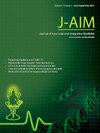Ameliorative effect of Inula racemosa Hook. F root extract against diethylnitrosamine induced hepatic damage in murine model
IF 1.9
Q3 INTEGRATIVE & COMPLEMENTARY MEDICINE
引用次数: 0
Abstract
Background
Liver disease is one of the most serious health problems worldwide. In the present scenario, the available therapies for liver ailments are not very effective and systemic toxicity inhibits their long-term use. Several medicinal plants have demonstrated promising effects against liver damage. These plants can help to prevent liver injury, reduce inflammation, enhance liver detoxification, and support liver cell regeneration and one such medicinal plant is Inula racemosa. The bioactive constituents present in the root extract of Inula racemosa i.e. alantolactone and isoalantolactone are responsible for its hepatoprotective potential.
Objectives
The current study aimed to elucidate the preventive action of Inula racemosa root extract against chemically-induced liver damage using Diethylnitrosamine (DEN).
Material and methods
Sprague Dawley (SD) 42-male rats were used in a 10-week study to examine the hepatoprotective effects of 3 different dosages (100, 250, and 500 mg/kg body weight) of Inula racemosa root extract against DEN-induced liver damage. The investigation included gross pathology, histopathology, immunohistochemistry (TGF-β and NF- κB), ultrasonography, and serum biochemistry (ALT, AST, ALP, Total protein, Albumin, Creatinine, and BUN).
Results
The in vivo research establishes Inula racemosa root extract's hepatoprotective efficacy by ameliorating biochemical parameters, lipid peroxidation, gross and histopathological alterations, and reduced immunohistochemical expression of TGF-β and NF- κB. The greatest defense against chemically-induced liver damage was provided by the highest dosage of the extract i.e. 500 mg/kg body weight.
Conclusions
The results of this investigation showed that the Inula racemosa root extract showed hepatoprotective activity against DEN-induced liver damage in the rat model.
总状菊的改良作用。七根提取物对二乙基亚硝胺致小鼠肝损伤的保护作用
背景肝病是世界范围内最严重的健康问题之一。在目前的情况下,现有的治疗肝病的方法不是很有效,而且全身毒性抑制了它们的长期使用。一些药用植物已经证明对肝损伤有很好的效果。这些植物可以帮助预防肝损伤,减少炎症,增强肝脏解毒,并支持肝细胞再生,其中一种药用植物是总状菊。总状菊根提取物中存在的生物活性成分,即alantolactone和异alantolactone具有保护肝脏的潜力。目的研究总状菊根提取物对化学诱导的二乙基亚硝胺(DEN)肝损伤的预防作用。材料与方法采用SD (sprague Dawley, SD) 42只雄性大鼠进行为期10周的实验,研究3种不同剂量(100、250和500 mg/kg体重)总状菊根提取物对den诱导的肝损伤的保护作用。检查方法包括大体病理、组织病理、免疫组织化学(TGF-β、NF- κB)、超声、血清生化(ALT、AST、ALP、总蛋白、白蛋白、肌酐、BUN)。结果总状菊根提取物通过改善生化指标、脂质过氧化、肉眼和组织病理学改变、降低TGF-β和NF- κB的免疫组织化学表达,在体内证实了总状菊根提取物的肝保护作用。对化学诱导的肝损伤的最大防御是最高剂量的提取物,即500毫克/公斤体重。结论总状菊根提取物对den诱导的大鼠肝损伤具有保护肝脏的作用。
本文章由计算机程序翻译,如有差异,请以英文原文为准。
求助全文
约1分钟内获得全文
求助全文
来源期刊

Journal of Ayurveda and Integrative Medicine
INTEGRATIVE & COMPLEMENTARY MEDICINE-
CiteScore
4.70
自引率
12.50%
发文量
136
审稿时长
30 weeks
 求助内容:
求助内容: 应助结果提醒方式:
应助结果提醒方式:


